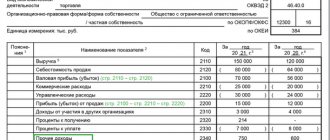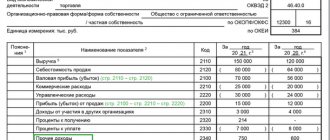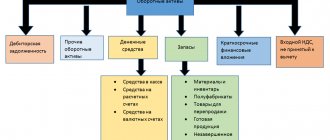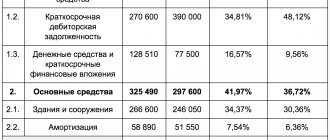Why is the balance sheet reformed?
The financial results of each organization during the reporting year are determined monthly.
This is required not only by the interests of persons using accounting data in their work, but also by the rules for closing cost accounts. The current financial result is formed on an accrual basis by adding to it data for the next closed month of the year. In accounting, it is reflected separately in an accounting account, different from the one that shows the financial results of work for previous years. This allows:
- control the process of generating financial results;
- analyze the ratio of its components;
- track its value without the influence of data from previous years.
However, at the end of the reporting year, its financial result must be added to the overall result of work for the entire period of the company’s existence, so that the new year begins with zero indicators in the accounting accounts of the current financial result. This is achieved by reforming the balance.
When to Reform the Balance Sheet
Due to its semantic purpose, the reformation of the balance sheet is the last accounting operation performed in the current year. Accordingly, it is carried out on the last day of the year - December 31.
However, there is 1 exception to this rule. At other times, the balance sheet is reformed if the company is liquidated before the end of the calendar year. The liquidation process is accompanied by the preparation of a liquidation balance sheet, which is subject to the general rules for the formation of this report, but is compiled on a different time frame.
For more information about the liquidation balance sheet, read the material “Liquidation balance sheet - an example of a zero balance sheet in the new form”.
Preparatory stage of the reformation
The balance sheet reform provides for the closure of accounts 90, 91, 99. At the same time, accounts 90 and 91 on which, in essence, a zero total result is recorded, since their subaccounts 90/9 and 91/9 accumulate throughout the year the amounts of profit (losses) from, accordingly, sales and other income/expenses should simply be reset to zero. Let us recall that the monthly generated current financial result is reflected in account 99 by writing off there the financial results generated in subaccounts 90/9 and 91/9.
Thus, balance reformation consists of 2 procedures:
- resetting data on accounts 90 and 91, which have a zero final balance, but contain figures that should be removed from these accounts;
- closing account 99, on which the financial result of the current year was generated, in order to add its value to the financial result of previous years.
Resetting the data available on accounts 90 and 91 is carried out by internal postings to these accounts, in which figures from all sub-accounts on the account are written off to sub-accounts 90/9 and 91/9.
Reformation in accounting
In order to complete the balance sheet reformation procedure, you must:
- close the accounts in which the company’s income, expenses and financial results of the company’s activities were recorded during the year. These are accounts 90 “Sales” and 91 “Other income and expenses”;
- include the financial result obtained by the company over the past year as part of retained earnings or uncovered losses.
How to close accounts 90 and 91
In accounting, income and expenses can be of two types:
- for ordinary activities that are reflected in account 90 “Sales”;
- others, which are accounted for in account 91 “Other income and expenses”.
In accordance with the Chart of Accounts, the following sub-accounts are opened for the “Sales” section:
- 90-1 “Revenue”;
- 90-2 “Cost of sales”;
- 90-3 “Value added tax”;
- 90-4 “Excise duties”;
- 90-9 “Profit/loss from sales”.
On December 31, the accountant needs to close all sub-accounts opened for account 90 “Sales”. This is done as follows:
a) the credit balance of subaccount 90-1 is closed by posting Debit 90-1 Credit 90-9 - subaccount 90-1 is closed at the end of the year;
b) debit balances of subaccounts 90-2, 90-3, 90-4, etc. are closed with entries Debit 90-9 Credit 90-2 (90-3, 90-4...) - subaccounts 90-2 (90-3, 90-4...) at the end of the year.
As a result, debit and credit turnovers in the subaccounts of account 90 will be equal. Thus, as of January 1 of the next year, the balance both for the specified account as a whole and for all sub-accounts opened to it will be equal to zero.
Example
In 2008, CJSC Aktiv received revenue from the sale of goods in the amount of 1,180,000 rubles, including VAT - 180,000 rubles. The cost of goods sold was 600,000 rubles, the cost of selling goods was 170,000 rubles. The Aktiva accountant made the following entries:
Debit 62 Credit 90-1 1,180,000 rub. — revenue from the sale of goods is reflected;
Debit 90-3 Credit 68 subaccount “Calculations for VAT” 180,000 rub. — VAT charged;
Debit 90-2 Credit 41,600,000 rub. — the cost of goods sold is written off;
Debit 90-2 Credit 44,170,000 rub. — sales expenses are written off;
Debit 90-9 Credit 99,230,000 rub. (1,180,000 - 180,000 - 600,000 - 170,000) - profit from sales is reflected.
On December 31, 2008, the Aktiva accountant must close all subaccounts to account 90. To do this, you need to make the following entries:
Debit 90-1 Credit 90-9 1,180,000 rub. — subaccount 90-1 was closed at the end of the year;
Debit 90-9 Credit 90-2,770,000 rub. (600,000 + 170,000) - subaccount 90-2 is closed at the end of the year;
Debit 90-9 Credit 90-3 RUB 180,000 — subaccount 90-3 was closed at the end of the year.
The following sub-accounts should be opened for account 91 “Other income and expenses”:
- 91-1 “Other income”;
- 91-2 “Other expenses”;
- 91-9 “Balance of other income and expenses.”
After you have closed the sub-accounts to account 90, you need to close all sub-accounts opened to account 91 “Other income and expenses”. To do this, the following entries are required: Debit 91-1 Credit 91-9 - subaccount 91-1 is closed at the end of the year; Debit 91-9 Credit 91-2 - subaccount 91-2 is closed at the end of the year.
Example
In 2008, CJSC Aktiv received income from leasing property in the amount of 2,360 rubles. The corresponding VAT amounted to 360 rubles. The costs associated with the provision of property for rent are equal to 3,600 rubles. Renting out property is not a normal activity for Aktiva.
The Aktiva accountant made the following entries:
Debit 76 Credit 91-1 2360 rub. — rent accrued for the reporting period;
Debit 91-2 Credit 68 subaccount “VAT calculations” 360 rub. — VAT is charged on rent;
Debit 91-2 Credit 02 (70, 69...) 3600 rub. — costs associated with leasing the property are reflected;
Debit 99 Credit 91-9 1600 rub. (2360 - 360 - 3600) - reflects the loss from other activities of the organization.
On December 31, 2008, the Aktiva accountant must close all subaccounts to account 91. This operation is formalized as follows:
Debit 91-1 Credit 91-9 2360 rub. — subaccount 91-1 was closed at the end of the year;
Debit 91-9 Credit 91-2 3960 rub. (360 + 3600) - subaccount 91-2 is closed at the end of the year.
The balance sheet reformation is carried out on December 31, after the last business transaction of the company is reflected in the accounting.
How to write off financial results
Let’s say that an accountant determined the financial result every month by comparing the turnover in accounts 90 and 91. The accounting employee wrote it off to account 99 “Profit and Loss.”
He reflected the result from ordinary activities as follows: Debit 90-9 Credit 99 - profit from ordinary activities is reflected; Debit 99 Credit 90-9 - loss from ordinary activities is reflected.
The result from other types of activities was formalized as follows: Debit 91-9 Credit 99 - profit from other types of activities is reflected;
Debit 99 Credit 91-9 - loss from other activities is reflected.
Please note: other income and expenses are recorded in account 91 “Other income and expenses”.
At the same time, we must not forget about account 99 “Profits and losses”, which reflects the accrual of income tax, as well as fines for tax violations. As a result, a credit (profit) or debit (loss) balance is formed on it, which must be written off as the last entry of the reporting year.
There are two possible wirings here. The first is carried out if at the end of the year the company made a profit, and it looks like this: Debit 99 Credit 84 - the net (retained) profit of the reporting year is written off.
The second is necessary if the company made a loss at the end of the year. This entry will be as follows: Debit 84 Credit 99 - reflects the net (uncovered) loss of the reporting year.
Example
Based on the results of 2008, CJSC Aktiv:
- received profit from ordinary activities (credit turnover on account 99) in the amount of 230,000 rubles.
- suffered a loss from other activities (debit turnover on account 99) in the amount of 1,600 rubles.
In addition, the company assessed income tax in the amount of 72,000 rubles. and paid various penalties in the amount of 1,500 rubles.
Thus, as of December 31, 2008, “Asset” will record a profit in the amount of 154,900 rubles. (230,000 - 1600 - 72,000 - 1500). With the last entry in December, the accountant will include these funds in retained earnings. The transaction will be reflected in accounting with the following entry:
Debit 99 Credit 84,154,900 rub. — net (retained) profit of 2008 was written off.
Aktiv shareholders will decide how to distribute this profit in 2009.
Source: book “Annual Report 2008”, ed. IN AND. Meshcheryakova
| New generation berator PRACTICAL ENCYCLOPEDIA OF AN ACCOUNTANT What every accountant needs. The full scope of always up-to-date accounting and taxation rules. Connect berator |
The final stage of the reformation
At the final stage, account 99 is closed. Let us recall that in this account, in addition to the financial results generated in correspondence with accounts 90 and 91, the following are taken into account:
- those who do not apply PBU 18/02 – the amount of accrued income tax;
- applying PBU 18/02 – the values of conditional income tax expense (income) and permanent tax liabilities.
Read about what kind of transactions when applying PBU 18/02 in accounting reflects the process of calculating the amount of income tax payable to the budget in the Ready-made solution from ConsultantPlus. If you do not already have access to this legal system, trial access is available for free.
The following may also be taken into account:
- income tax recalculations;
- accrued tax penalties.
The balance sheet reformation is completed by transactions writing off the data accumulated on account 99 to account 84.
Closing the annual balance sheet
What transactions should be used to close financial performance accounts when reforming the balance sheet?
How are financial results reflected in the company's financial statements?
What should be taken into account if the work lasts more than a year?
Closing the annual balance sheet is the final stage in the preparation of annual financial statements. Accounts are closed only after an annual inventory of property and liabilities.
In continuation of the article published in the previous issue of the magazine (“Adjustment of estimated liabilities before closing the annual balance sheet”), we will talk about what entries should be made to close financial results accounts when reforming the balance sheet, how financial results are reflected in the company’s financial statements, and give examples.
The reform implies that all financial performance accounts (90 “Sales”, 91 “Other income and expenses” and 99 “Profits and losses”) are closed, their balance at the end of the year is zero.
After closing the accounts, the final result is displayed - profit or loss, which is transferred to account 84 “Retained earnings (uncovered loss)”, thereby forming the total work for the year. Final records for balance sheet reformation are made as of December 31 of the current year.
In this case, it is also necessary to take into account the results from the main activities in account 90 “Sales”, as well as from other transactions reflected in account 91 “Other income and expenses”. Therefore, these accounts are closed first at the end of the year.
Then close account 99 “Profits and losses”. During the year, the result of the company’s work was attributed to it on a monthly basis, i.e., profit or loss from accounts 90.9 “Profit/loss from sales” and 91.9 “Balance of other income and expenses.” On separate sub-accounts, accounts 99 reflect the amounts of accrued income tax and fines for tax offenses.
The balance on account 90 “Sales” is 0. Transactions on this account are reflected throughout the year with a cumulative total in subaccounts.
Transactions on subaccounts of account 90 “Sales” are reflected in table. 1.
At the end of the year, account 90 “Sales” is closed with internal records. Closing operations are in table. 2.
As a result of entries on January 1 of the year following the current year, the balance in the subaccounts of account 90 “Sales” becomes equal to 0.
The balance on account 91 “Other income and expenses” during the year is the same as on account 90, equal to 0. Transactions on this account are reflected during the year on an accrual basis in sub-accounts.
Transactions on subaccounts of account 91 are reflected in table. 3.
At the end of the year, account 91 is closed with internal records (transactions for closing this account are in Table 4). As a result, on January 1 of the year following the current year, the balance in the subaccounts of account 91 becomes equal to 0.
After closing accounts 90 and 91, account 99 “Profit and Loss” is closed. During the year, the sub-accounts of this account took into account the financial results from the company's business activities, calculated income tax, and reflected penalties for taxes and fees.
Reflection of transactions on subaccounts of account 99 - in table. 5.
At the end of the reporting year, when preparing annual financial statements, account 99 is closed with the final entry of December.
At the end of the year, savings accounts are closed, the balance sheet is reformed and the financial result is displayed.
Balance sheet reformation: postings if profit is made
The accounting of LLC “Success” at the end of the year for account 99 reflects:
- subaccount 99/1 “Profits and losses” - 210,000 rubles. (credit balance);
- subaccount 99/2/1 “Conditional income tax expense” - 42,000 rubles. (debit balance);
- subaccount 99/2/3 “PNO” - 6,300 rubles. (debit balance).
When reforming the balance sheet, the postings will be as follows:
- Dt 99/1 Kt 99/2/1 - 42,000 rubles;
- Dt 99/1 Kt 99/2/3 — 6,300 rub.
The result formed as a result in subaccount 99/1 (210,000 – 42,000 – 6,300 = 161,700 rubles) will give the credit balance. Its write-off will reflect the last operation to reform the balance sheet - posting Dt 99/1 Kt 84 in the amount of 161,700 rubles, equal to the net profit for the reporting year.
How profit from sales is reflected in financial statements, see the Guide from ConsultantPlus. Trial access to the system can be obtained for free.
Typical entries for balance sheet reformation
Based on the results of reconciliation of accounts 90 and 91, the accountant determines the financial result of the enterprise - the presence of profit or loss. Let's look at how to carry out accounting in both cases using examples.
Reformation of the balance sheet with profit
Let's imagine that the main activity of Reforma LLC is wholesale trade in consumer products. At the end of 2015, sales revenue amounted to RUB 7,515,000, VAT RUB 1,146,356. with a product cost of RUB 4,330,000. The amount of sales expenses amounted to RUB 980,000. Other income on account 91.1 - 113,000 rubles, other expenses on account 91.2 - 312,000 rubles.
At the end of the year, Reforma LLC received a profit from sales in the amount of RUB 1,058,644. (7,515,000 - 1,146,356 - 4,330,000 - 980,000). A loss from other activities of RUB 199,000 was also identified. (312,000 - 113,000).
The balance sheet as of December 31, 2015 looks like this:
| Check | Name | Dt (amount) | Kt (amount) |
| 90 | Sales | — | — |
| 90.1 | Revenue | RUB 7,515,000 | |
| 90.2 | Cost of sales | RUB 4,330,000 | |
| 90.3 | VAT | RUB 1,146,356 | |
| 90.9 | Profit (loss) from sales | RUB 1,058,644 | |
| 91 | Other income and expenses | — | — |
| 91.1 | Other income | 113,000 rub. | |
| 91.2 | other expenses | 312,000 rub. | |
| 91.9 | Balance of other income and expenses | 199,000 rub. |
The accountant of Reforma LLC made the following entries at the end of the year:
| Dt | CT | Description | Sum | Document |
| 90.1 | 90.9 | Closing a subaccount for accounting for sales revenue | RUB 7,515,000 | Turnover balance sheet |
| 90.9 | 90.2 | Closing a subaccount for accounting for cost of sales (4,330,000 + 980,000) | RUB 5,310,000 | Turnover balance sheet |
| 90.9 | 90.3 | Closing the VAT amount | RUB 1,146,356 | Turnover balance sheet |
| 91.1 | 91.9 | Closing the other income subaccount | 113,000 rub. | Turnover balance sheet |
| 91.9 | 91.2 | Closing the subaccount of other expenses | 312,000 rub. | Turnover balance sheet |
| 99.1 | 99.9 | Reflection of profit (1,058,644 - 199,000) | RUB 859,644 | Turnover balance sheet |
Reformation of the balance sheet with a loss
Let's say the main activity of Magnit Plus LLC is wholesale trade in garden tools. At the end of 2015, Magnit Plus LLC sold garden equipment in the amount of 2,335,000 rubles, VAT 356,186 rubles. with a product cost of RUB 1,215,000. The total amount of depreciation of fixed assets, as well as transport, warehouse and management expenses amounted to RUB 814,000.
The balance on accounts 90.1 - 90.4 and 44 as of December 31, 2015 is as follows:
- Kt 90.1 (revenue from sales) - RUB 2,335,000;
- Dt 90.2 (cost of goods sold) - RUB 1,215,000;
- Dt 90.3 (VAT on the amount of revenue) - RUB 356,186;
- Dt 44 (selling expenses) - RUB 814,000.
The accountant of Magnit Plus LLC made the following entries to reform the balance sheet:
| Dt | CT | Description | Sum | Document |
| 90.2 | 44 | Write-off of sales expenses at the end of the year | 514,000 rub. | Turnover balance sheet |
| 99 | 99.9 | Reflection of loss from the sale of garden equipment at the end of the year (RUB 2,335,000 - (RUB 1,215,000 + RUB 356,186 + RUB 814,000) | RUB 50,183 | Turnover balance sheet |
Balance sheet reformation: postings if a loss is received
The accounting of LLC “Success” at the end of the year for account 99 reflects:
- subaccount 99/1 “Profits and losses” - 210,000 rubles. (debit balance);
- subaccount 99/2/2 “Conditional income for income tax” - 42,000 rubles. (credit balance);
- subaccount 99/2/3 “PNO” - 6,300 rubles. (debit balance).
When reforming the balance sheet, the postings will be as follows:
- Dt 99/2/2 Kt 99/1 - 42,000 rubles;
- Dt 99/1 Kt 99/2/3 — 6,300 rub.
As a result, a debit balance in the amount of 174,300 rubles will be formed on subaccount 99/1.
(–210,000 + 42,000 – 6,300 = 174,300 rubles). It will be written off to account 84 by posting Dt 84 Kt 99/1 and reflect the amount of net loss for the reporting year.
Organization on OSNO
To determine the financial result when closing reporting periods during the year (including at the end of December), the accountant had to monthly write off financial results from core activities and other operations from subaccounts 90-9 and 91-9 to account 99 “Profits and losses”.
He reflected the result of ordinary activities as follows:
| Wiring | Content |
| D 90-9 K 99 | profit from ordinary activities is reflected |
| D 99 K 90-9 | loss from ordinary activities is reflected |
| D 91-9 K 99 | profit from other activities is reflected |
| D 99 K 91-9 | loss from other activities is reflected |
That is, on December 31, account 99 “Profits and losses” should show the net financial result (profit or loss) of the reporting year.
The accountant will attribute it to account 84 “Retained earnings (uncovered loss)” by posting:
Debit 99 subaccount “Net profit (loss)” Credit 84 - net (retained) profit of the reporting year is written off;
Debit 84 Credit 99 subaccount “Net profit (loss)” - reflects the net (uncovered) loss of the reporting year.
An example of balance sheet reformation
As of December 31, 2022, the accountant reflected the following balance in accounting:
- for subaccount 90-1 - 12,000,000 ₽;
- for subaccount 90-2 - 8,000,000 ₽;
- for subaccount 90-3 - 2,000,000 rubles;
- for subaccount 91-1 - 300,000 ₽;
- for subaccount 91-2 - 100,000 ₽;
- on the credit of account 99 subaccount “Profit before tax” - 2,200,000 ₽.
“Alpha” determines the current income tax according to the declaration, the balances are reflected in the accounting:
- on the debit of account 99 subaccount “Current for income tax” - 440,000 ₽;
- on the debit of account 99 sub-account “Deferred tax” - 30,000 ₽.
When reforming the balance sheet, the accountant made the following entries:
Debit 90-1 Credit 90-9 - 12,000,000 ₽ - subaccount 90-1 is closed;
Debit 90-9 Credit 90-2 - 8,000,000 ₽ - subaccount 90-2 is closed;
Debit 90-9 Credit 90-3 - 2,000,000 ₽ - subaccount 90-3 is closed;
Debit 91-1 Credit 91-9 - 300,000 ₽ - subaccount 91-1 is closed;
Debit 91-9 Credit 91-2 - 100,000 ₽ - subaccount 91-2 is closed;
Debit 99 Credit 84 - 1,730,000 ₽ (2,200,000 ₽ - 440,000 ₽ - 30,000 ₽) - net profit for 2022 is included in retained earnings.
This completes the reformation of the organization’s balance sheet for 2022.
Tax nuances when reforming the balance sheet
Due to differences in the recognition of income and expenses in accounting and tax accounting, the following situation is possible: according to tax accounting data, the company’s activities are unprofitable, but in accounting there is a profit.
In this case, the amount of income tax cannot be negative, and in this case there is no income tax (no profit - no tax). According to the law, the resulting tax loss can be taken into account over the next 10 years (Article 283 of the Tax Code of the Russian Federation).
In the described situation, the accountant will have to record a deferred tax asset as of December 31. It is easy to calculate: the amount of the tax loss should be multiplied by the income tax rate. You need to make an entry for the amount received: Dt 09 Kt 68.
As a result, the amount of accrued income tax becomes zero, and there are no discrepancies between tax accounting and financial statements.
About the rules for transferring losses and the restrictions that apply, read the material “How and for how long can losses be carried forward?” .
How to close accounts 90 and 91
The balance sheet reform operation consists of two stages:
- close the accounts in which the company's income and expenses were recorded during the year. These are accounts 90 “Sales” and 91 “Other income and expenses”;
- include the financial result obtained by the company over the past year as part of retained earnings or uncovered losses.
The article was provided by the editorial board of the book “Annual Report Edited by V.I. Meshcheryakov”
Book of the Year!
“Annual report edited by V.I. Meshcheryakov” is already on sale. There are several purchasing options: just a book, a package of information publications for accounting, and with a subscription to the press.
In accounting, there are two types of income and expenses:
- for ordinary activities, which are reflected in account 90 “Sales”;
- others, which are recorded on account 91 “Other income and expenses”.
The financial result for ordinary activities is formed monthly on account 90 “Sales”.
In accordance with the chart of accounts, subaccounts are opened for it:
- 90-1 “Revenue”;
- 90-2 “Cost of sales”;
- 90-3 “Value added tax”;
- 90-4 “Excise duties”;
- 90-9 “Profit/loss from sales”.
On December 31, the accountant needs to close all sub-accounts opened for account 90 “Sales”.
Do it like this:
a) the credit balance of subaccount 90-1 is closed by posting:
DEBIT 90-1 CREDIT 90-9
- subaccount 90-1 was closed at the end of the year;
b) debit balances of subaccounts 90-2, 90-3, 90-4, etc., except for subaccount 90-9, are closed with transactions:
DEBIT 90-9 CREDIT 90-2 (90-3, 90-4, …)
- subaccounts 90-2 (90-3, 90-4, ...) are closed at the end of the year.
As a result of the entries made, the debit and credit turnovers in the subaccounts of account 90 will be equal. Thus, as of January 1 of the next year, the balance both for account 90 as a whole and for all sub-accounts opened to it will be equal to zero.
Example. How to close an account 90
In 2022, Dynamite LLC received revenue from the sale of goods in the amount of RUB 1,770,000. (including VAT - 270,000 rubles). The cost of goods sold was 900,000 rubles, the cost of selling goods was 255,000 rubles. The accountant of Dynamite LLC made the following entries:
DEBIT 62 CREDIT 90-1
- RUB 1,770,000 – revenue from the sale of goods is reflected;
DEBIT 90-3 CREDIT 68, SUBACCOUNT “VAT CALCULATIONS”
- 270,000 rub. – VAT is charged;
DEBIT 90-2 CREDIT 41
- 900,000 rub. – the cost of goods sold is written off;
DEBIT 90-2 CREDIT 44
- 255,000 rub. – sales expenses are written off;
DEBIT 90-9 CREDIT 99
- RUB 345,000 (1,770,000 – 270,000 – 900,000 –– 255,000) – profit from sales is reflected.
On December 31, 2022, Dynamite’s accountant must close all subaccounts to account 90. To do this, you need to make the following entries:
DEBIT 90-1 CREDIT 90-9
- RUB 1,770,000 – subaccount 90-1 is closed at the end of the year;
DEBIT 90-9 CREDIT 90-2
- RUB 1,155,000 (900,000 + 255,000) – subaccount 90-2 is closed at the end of the year;
DEBIT 90-9 CREDIT 90-3
- 270,000 rub. – subaccount 90-3 is closed at the end of the year.
In this case, subaccount 90-9 is closed automatically.
Accounting for other income and expenses is carried out on account 91 “Other income and expenses”. The following sub-accounts are opened for this account:
- 91-1 “Other income”;
- 91-2 “Other expenses”;
- 91-9 “Balance of other income and expenses.”
After you have closed the sub-accounts to account 90, you need to close all sub-accounts opened to account 91 “Other income and expenses”.
Do it like this:
DEBIT 91-1 CREDIT 91-9
- subaccount 91-1 was closed at the end of the year;
DEBIT 91-9 CREDIT 91-2
- subaccount 91-2 was closed at the end of the year.
Example. How to close account 91
In 2022, Market LLC received income from renting out property in the amount of RUB 159,300. (including VAT - 24,300 rubles).
Expenses associated with the provision of property for rent amounted to 162,000 rubles.
Renting out property is not a normal activity for Market.
Market's accountant made the following entries:
DEBIT 76 CREDIT 91-1
- RUB 159,300 – rent accrued for the reporting period;
DEBIT 91-2 CREDIT 68, SUBACCOUNT “VAT CALCULATIONS”
- RUB 24,300 – VAT is charged on rent;
DEBIT 91-2 CREDIT 02 (70, 69, …)
- 162,000 rub. – costs associated with leasing the property are reflected;
DEBIT 99 CREDIT 91-9
- 27,000 rub. (159,300 – 24,300 – 162,000) – loss from other activities of the organization is reflected.
On December 31, 2022, the Market accountant must close all subaccounts to account 91. To do this, you need to make the following entries:
DEBIT 91-1 CREDIT 91-9
- RUB 159,300 – subaccount 91-1 was closed at the end of the year;
DEBIT 91-9 CREDIT 91-2
- RUB 186,300 (24,300 + 162,000) – subaccount 91-2 is closed at the end of the year.
In this case, subaccount 91-9 is closed automatically.
Results
Balance sheet reformation is a process that leads to the resetting of data on accounts 90, 91 and 99. The first 2 accounts, which have a zero final balance due to the rules for forming the figures reflected on them, are closed with internal postings.
Account 99 is closed using internal entries that close the analytics for it at the expense of the overall financial result, and a final entry that writes off the amount of net profit (loss) to account 84. You can find more complete information on the topic in ConsultantPlus. Free trial access to the system for 2 days.





